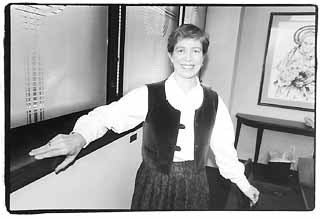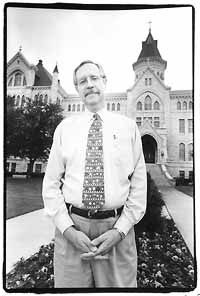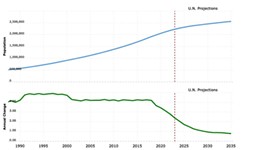A Saintly Anchor
South Austin Landmark
By Mike Clark-Madison, Fri., Dec. 4, 1998
|
|
More active links to the community were still very informal and mostly based in the local parishes, though Brother Raymond Fleck, the school's president during its rapid postwar growth spurt, was the first St. Ed's leader to join the Rotary Club and take a visible role in Austin civic life. For the most part, however, Fleck, and his successors Edgar Roy and Brother Stephen Walsh, had their hands full managing the rapid expansion, and the corollary shaky financial situation, of the university. (Lack of resources led to the closure in 1967 of St. Edward's High School.)
When the 32-year-old Brother Stephen, himself a St. Ed's graduate, took over in 1971, the school was running an annual deficit of more than $300,000. Though he managed to stanch the immediate bleeding, by the time he retired for health reasons in 1984, St. Ed's long-term viability was in some doubt; there was an active campaign to close down the hilltop campus entirely, move out to the suburbs (specifically to the St. Edward's Tract, at Loop 360 and Spicewood Springs Road), and start over.
Into the Spotlight
Enter Dr. Patricia Hayes, the woman who for a generation has defined St. Ed's in the minds of Austinites, and who in the process has become one of the town's most admired -- and most powerful -- citizens. "When I first became president," Hayes recalls, "people were saying that we shouldn't stay in the city, that we should leave town and rebuild out on Loop 360, and that we certainly shouldn't renovate the Main Building. But that's the first thing we did."
Fourteen years later, St. Ed's is unquestionably stronger financially than it's ever been, largely due to Hayes' awe-inspiring fundraising and networking skills. It has also become a much more formal player in Austin public life -- Hayes served a term as chair of the Greater Austin Chamber of Commerce, and famously made Austin the summer home of the Dallas Cowboys -- and particularly in South Austin life. From mentoring programs in the local elementary schools to mediation services to local neighborhoods, from its own capital investments along the South Congress corridor to student-run volunteer programs in the nearby low-income Meadowbrook Apartments, it's hard to find a civic initiative on the Southside that doesn't in some way involve St. Ed's.
"Strengthening the neighborhoods obviously and absolutely strengthens St. Edward's," Kinsey says. "Put yourself in the shoes of a parent turning his or her 18-year-old over to us. An active, well-kept neighborhood around the campus is more reassuring than a place with razor wire around it. It's a more humane and pleasant environment."
|
|
Hayes notes that "universities respond to their communities along a spectrum, and I would say that St. Ed's is in the third quartile. Moving out of the city into a suburban space would be one end, and the other end is where all faculty and students are involved in community improvement projects. I don't think St. Ed's is there yet, but we tried to make it a place where the community felt at home and found a home."
Hayes stunned many both on and off campus when, earlier this year, she resigned her post to take a newly created position with the Seton Healthcare Network, and Southside neighborhood and community groups realize that her eventual successor may not be as ready as Hayes to equate St. Ed's needs and goals with those of South Austin. "The president is critical in holding up the vision for the relationships that we want to exist" between St. Ed's and the larger community, Kinsey says.
"The first step in the search process [for a new president] was to ask the St. Ed's community to think about the leadership characteristics the next president should have," Kinsey continues. "We'll never find another Pat Hayes -- she was unique and gifted and the person for the moment. We need to find the next Pat Hayes, for the next moment. But a focus on the external community is definitely one of those key characteristics; if Pat's track record shows us anything, it's the value of service to the community to the institution and to student learning."
And there's certainly no shortage of ways for St. Ed's to continue to serve. Kinsey notes, referring to the chronic sex trade plied just across the street from campus, "There are plenty of opportunities to fulfill our social mission right on South Congress. ... We aim to provide services to those who need them, and to awaken in the students a sense of trusteeship for their community. We're not doing anybody any service if the people who graduate from here don't have a clue. Our mandate is to treat everyone with dignity and work for the common good, and to do that, we must maintain a dialogue and understand the changing needs of the community."
Got something to say on the subject? Send a letter to the editor.










